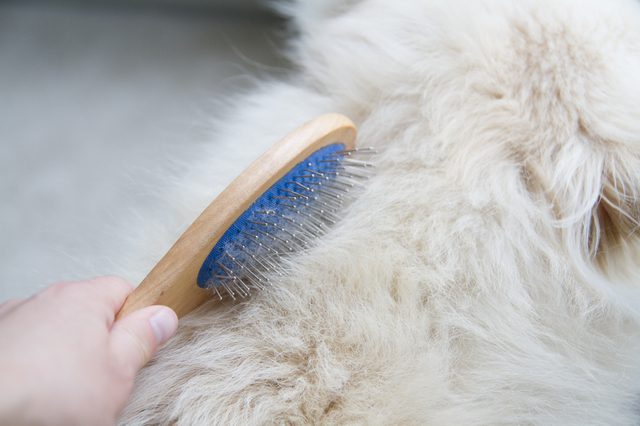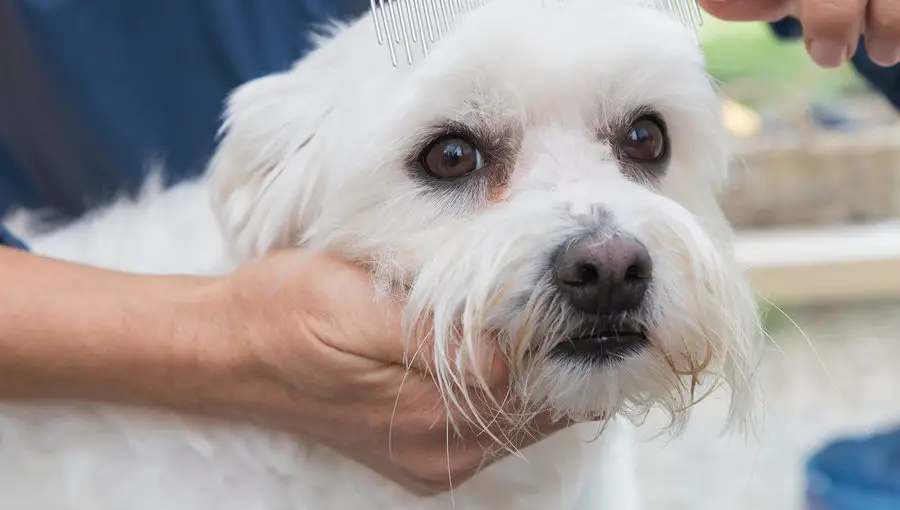How to Remove Stains from White Dog Fur
Remove Stains from White dog Fur - Tips to Keep the White Fur Neat and Clean
Dogs, like other mammals, have hair follicles embedded under their skin. Hair follicles are the minuscule holes where hair takes root and grows. Because of this covering, dogs can keep themselves warm without the help of clothing.
How does it get stained?
Because of a dog’s active lifestyle, their fur, especially light colored ones, can get stained easily. This could be from the environment they run around in. Thus, it is the owner’s responsibility to look after his or her dog’s personal hygiene.

Top 10 Dirty Dog Food Industry Secrets. Prepare to have your mind blown!
Every dog owner needs to know these 10 secrets of the dog food industry.
I'm truly Gobsmacked !
Aside from the dirt and debris that the dog’s fur might get whilst playing outside, fur stains can also be caused by saliva and/or tears. Tear stains frequently happen, especially to small dogs because of their narrow tear ducts. The substances these ducts secrete harden at the sides of the eye and can be difficult to remove.
A dog’s fur can be difficult to maintain, especially if it is white and longer in length. But, fret not! In this article, we will provide you with basic tips on how to remove stains on their coat easily.

Via Cuteness
Steps on how to remove fur stains
Step 1: Check under their fur for any wounded or inflamed areas.
Cleansers made for dogs can be made up of harsh chemicals that can seep into open wounds and go directly to their bloodstream. This may lead to illness. Also, these wounds can serve as a symptom or another issue, and that your dog needs to be taken to the veterinarian.
Step 2: Examine the stains and what caused them.
Some stains have to be treated with special care. For example, dirt stains can be removed from the white fur with ordinary dog shampoo and warm water, while tear stains, especially if accompanied with irritated eyes, need to be removed by the vet in order to examine if said stains are an indication of a disease.
Step 3: Depending on the stain source, wash and lather up your dog with a shampoo that would remove the stain.
Urine and fecal stains should be dealt with either an enzymatic or clarifying shampoo. Enzymatic shampoos remove stains that are made up of proteins, like saliva, tears, and blood. And because white fur is made up of keratin, which is a protein, it also whitens your dog’s coat.
Clarifying shampoos have the same effect as enzymatic ones, with the additional benefit of removing hardened dirt stuck under your dog’s paw like clay and soil.
However, these products may contain harsh chemicals. It must not be used frequently. But if you do, it must immediately be followed by a hypoallergenic conditioner to keep their fur from drying out.
In washing and lathering your dog, avoid the sensitive areas, specifically the eyes, ears, and mouth. Give the tail, muzzle, lower body area and the paws extra attention since these are the ones most prone to dirt. Let the lather stay up to five minutes, and do not leave your dog until the time is up.
Step 4: Rinse with warm water.
Make sure that the water is not too hot. If you can, test it out with your elbow first—using hot water can injure your pet’s sensitive skin. While rinsing, run your fingers through each hair section to make sure that no excess shampoo is trapped in the strands.
Step 5: Apply conditioner.
Conditioners are meant to nourish and lock in moisture inside the hair cells. This would add shine to the locks and protects the white fur from additional stains. Rinse again with warm water, then dry your dog with a towel using dabbing motions.
Step 6: Brush white dog fur with a brush suitable for its hair type.
Pin brushes, as shown below, is ideal for dogs whose hair are long and thick, while the slicker one (shown on the right) is for those who have more delicate and more sensitive hair. Brush the fur to the direction of the hair growth to reduce falling hair and tangles.
Maintaining White Fur White
The steps mentioned above are made only for cleaning purposes. As for maintenance, it is a different (and more tedious) matter.
White fur is in itself difficult to maintain. For one, stains on the fur coat are easily seen and can be distracting to the dog’s appearance. Thankfully, manufacturers are able to provide products that could keep white fur coats pristine.
Below are some things you can apply to maintain the whiteness of your dog’s fur:
● Bleaching Shampoo
Its main ingredient is hydrogen peroxide which is great for removing yellow stains. However, it can be harsh to the skin, and must, therefore, be used in moderation.
However, if you cannot afford it, a bleaching paste can be made at home using 10-20% hydrogen peroxide and cornstarch, with the option of adding milk of magnesia. It must only be applied to areas that have yellow marks caused by stains and must be done before applying shampoo on the dog. The paste must remain on the problem area for up to 15 minutes before rinsing with warm water.
● Bluing shampoo
This type of shampoo relies on optical illusion to make your dog’s white fur look white in appearance. Applying it can be trickier than other shampoos, so extra attention is needed to avoid turning the white fur into blue. It must be lathered and massaged into the fur coat until the lather turns white. After, rinse it off with warm water.
● Changes in lifestyle
Some stains, specifically those that are red or brown, is caused by either the diet or an underlying infection. In both cases, the owner must bring his or her dog to the veterinarian to find out the root cause and to decide on the treatment.
Sure, maintaining white fur can be difficult, but it’s simply part of our responsibility as dog owners. At the end of the day, the benefits of having loyal companionship from our canine friends far outweigh the responsibilities it may entail.
If your pup has been caught in a messy situation, you know how hard it can be to get rid of tough stains. Not only are those stubborn spots unsightly, but they can be difficult to remove. In this blog post, we'll discuss the steps you can take to get rid of spots on white dog fur. We'll cover everything from the best cleaning solutions to what you can do to prevent future stains. Whether your pup had an accident inside or got into something outside, this blog post will help you restore your pup's white fur to its original, beautiful condition.
Why dog's coat is white?
The coat of a dog can be a variety of colors, including white. It is genetic and can be either a single-gene or multi-gene trait. Dogs with a single-gene trait rarely have any white markings and are often called "all-white" or "white-factored". Dogs with a multi-gene trait will have white markings on their coat, such as on their face, legs, chest, and tail.
The color of a dog's coat is primarily determined by genetics. Many breeds, such as the Bichon Frise, Maltese, West Highland White Terrier, and Samoyed, are bred specifically for their white color.
White fur dogs can also be inherited from parent breeds. For example, a German Shepherd and a white poodle may produce a white puppy. Some are caused by a condition called albinism. Albinism is caused by a lack of the pigment melanin, which gives the coat its color.
For certain breeds, it can provide camouflage in snowy or icy conditions. Some owners also find them to be visually appealing.
Why do white dogs require special care?
White pups and dogs require special care for removing coat spots because their coat is so light that regular shampooing and brushing can cause discoloration. In order to keep their coat looking their best, they require special shampoos and conditioners that are specifically designed to help keep their coat clean and healthy without fading. Additionally, special grooming techniques, such as combing and brushing, should be used as they can help reduce the amount of staining that occurs over time. Finally, it is important to be vigilant in removing dirt and debris as quickly as possible, as any build-up can be difficult to remove.
What causes brown stains on white dog breeds?
Canine breeds, such as Bichons, Maltese, and Poodles, are particularly prone to developing brown stains on their coat. Here are the most common causes of stains - They are most likely caused by saliva and oils that accumulate on the coat, especially around the mouth and eyes. Additionally, exposure to excess moisture and humidity, such as from a damp environment or swimming, can cause bacteria to build up on the coat and lead to discoloration. Lastly, tea tree oil and some other topical products contain natural colorants that can cause discoloration, especially if a dog is frequently exposed to them.
How to Remove Stains from White Dog Fur - To get stains out of your dog’s white fur, follow these steps:
Here are some steps you can take to make sure your pup’s coat looks clean and beautiful again.
1. Brush the stained spots. This will help any surface dirt and debris that might be hiding the stained spots.
2. Next, make a solution of 1 part white vinegar and 2 parts water. Use a clean cloth or sponge to apply the solution to the spotted area and let it sit for about 5 minutes.
3. Using a clean cloth, dab the area with the solution to remove the spot.
4. If the stain is still visible, try using a stain/ dirt remover specifically designed for pet stains. Follow the instructions on the package and apply the solution to the stained area.
5. To finish up, use a dry cloth to dab the area dry and brush your pup’s coat with a clean brush.
By following these steps, you should be able to remove the stain from your pup’s white coat. If the spot is especially stubborn, you may want to consider bringing your pup to a professional groomer who can use special techniques to remove stubborn spots. With these steps, you can help keep your pup’s coat looking its best.
Whitening Shampoos and Conditioners
Another effective way to remove dirt is to use whitening shampoos and conditioners. These products are specifically designed to help remove dirt and grime from the white coat and get rid of any yellowing that can occur over time. Make sure to use the appropriate shampoo and conditioner for the breed and look for those marked explicitly as whitening. When using the shampoo, use a soft brush or comb to get rid of any loose dirt and debris, and then massage the shampoo into the coat. Rinse and then follow up with the conditioner. When rinsing, use plenty of warm water, and be sure to rinse until all traces of the shampoo are gone. This will help keep your white pup looking beautiful and clean.
Commercial pet stain remover
Commercial pet stain and dirt removers are a great way to quickly and easily remove dirt from your white canine's coat. These products are designed to specifically target pet dirt and eliminate them from fabrics, carpets, and other surfaces. They are usually formulated to be safe for any type of fabric or surface and won't cause any damage or irritation to your pet. Commercial pet stain/ dirt removers can effectively remove a variety of pet dirt, including urine, vomit, mud, and other pet messes, with just one application. Some products even come with special enzymes that help to break down and eliminate tough pet odors. They are easy to use and can make quick work of any pet blemishes, leaving your white friend looking and smelling clean and fresh.
How to Clean a White Dog's Fur?
In order to clean your white dog's coat, you should start by brushing its coat with a brush specifically designed for dogs to remove any shedding fur and dirt. Then, use a gentle dog shampoo to give your pup a good bath. Be careful to avoid getting soap in your dog's eyes, ears, and nose. Once the bath is complete, rinse off your dog with warm water and gently pat them dry with a clean towel. After the bath, use a brush to brush the fur out in the direction of hair growth. This will help to restore the natural oils and keep your pup's coat looking bright and healthy.
Easy way to get stains out of white dog fur
Clearing stains on a white canine's coat can be a tricky task. The best method for tackling this issue is to use a combination of gentle soap, hydrogen peroxide, and white vinegar. Start by dampening the coat with warm water and then gently massage the soap into the coat. Once the soap has been applied, rinse the coat with lukewarm water and then dab the blemish with a cloth soaked in hydrogen peroxide solution. Finally, use a cloth soaked in white vinegar to lightly dab the spot. This will help to loosen and remove the dirt. Repeat the process until the stain is completely gone. This method is also effective in removing urine stains as well.
Pick up some Stain removal shampoo for your white Dog
If you have a white pooch, you know how important it is to keep their fur looking its best! Pick up some specialty shampoo designed specifically for white coats to help keep your pup's fur in pristine condition. This type of shampoo is designed to help eliminate dullness, yellowing, and discoloration while also keeping your pup's fur shiny and soft. Plus, with its special blend of conditioning ingredients, it's sure to leave your pup's coat looking and feeling great. So go ahead and pick up some specialty shampoo to keep your white pooch clean and stain-free!
Why do white dog breeds have stains around the eyes?
White canine breeds are prone to developing new stains around their eyes due to the light pigment of their fur. These stains can occur when the natural oils and sweat on their face and fur mix with the dust and dirt in the air and settle around their eyes. This can result from the natural oils coming into contact with the sun's UV rays and oxidizing, or from the dog's tear ducts producing too many tears, which can contain proteins that cause discoloration. The stains may also form from the dog's facial structure and the shape of the eyes, which can cause the fur and skin to rub against each other and cause staining. In any case, these stains can be treated by cleaning the fur surrounding the eyes and using a damp cloth or gentle cleanser.
How to Remove tear stains - How to Groom a Dog Around the Eyes
Removing tear stains in white coat dogs can be a difficult task, but it can be done with the right products and techniques. Start by cleaning the area around the tear stains with mild shampoo. After bathing the dog thoroughly, use a damp cotton ball or swab dipped in hydrogen peroxide to lightly scrub the stained area. This will help to loosen the dirt and bacteria that may have built up in the stain. For deep-set stains, use a cotton swab dipped in a mixture of equal parts white vinegar and water and gently scrub the area. Once the stains have been removed, use a special tear stain/ dirt remover designed for dogs to prevent future staining. Lastly, make sure to regularly groom your dog to keep the area clean and to prevent future staining.
How Do You Remove Dog Beard Stains?
To remove dog beard stains, it is best to start by wiping the area with a wet cloth to remove any excess dirt or debris. You can then apply a cleaning solution that is specifically designed to remove pet stains. Popular solutions include baking soda and white vinegar, or a combination of laundry detergent and water. Once the solution has been applied, use a scrub brush to lightly scrub the stained area. After scrubbing, rinse the area with warm water and a cloth and then allow it to air dry. If the stain remains, you may need to repeat the process a few times.
Conclusion
In conclusion, removing stains from white fur can be a daunting task. However, by utilizing the right products, techniques, and cleaning methods, you can restore your pup’s coat to its original, pristine look. Start by identifying the type of stain, then use warm water and mild detergent to treat the stain. If this doesn’t work, then use a specialized stain/dirt remover or a homemade solution. In addition, it’s a good idea to brush your dog regularly to help keep its coat clean and free of debris. With a little bit of extra care, your pup’s coat can be restored to its original glory.



